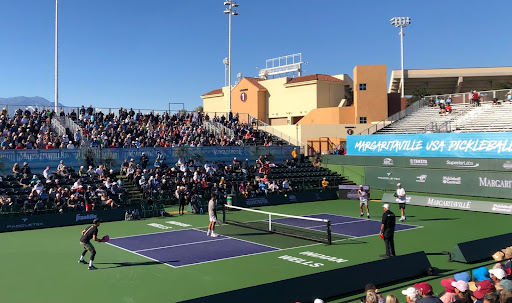How much do you like outsmarting your opponents versus overpowering them?
It’s an extremely satisfying feeling to construct a pickleball point by placing precise dinks in the opponent’s non-volley zone forcing a pop-up that you or your teammate ultimately puts away for the winner.
Creating rallies of this nature doesn’t come without crosscourt shots, so implementing a crosscourt strategy into your game is just smart pickleball; and can lead to many future pop-ups and winning opportunities.

Photo Credit: Sara McInnes
If you haven’t already, go and find some pickleball videos on YouTube that demonstrate some great crosscourt rallies. Crosscourt play will usually produce longer rallies and exemplifies strategic pickleball at its best.
First, let’s review how to hit cross court, mainly with a focus on dinking, but much of the advice below can also relate to a crosscourt volley:
- Slightly turn the body in the angle you’re going for, turn the shoulders and hips towards the ball as it’s coming to you - this lean-in is crucial because standing square to the net can prevent you from creating that nice diagonal pathway that you’re looking to create
- Once you’re on the angle let the shoulder move in a straight line using that hinge motion the paddle will lead and guide the ball on a diagonal
- Recenter yourself and recover from the shot immediately to prepare for the next one
-Jul-09-2023-07-27-49-4834-PM.jpg?upscale=true&width=1024&upscale=true&name=unnamed%20(1)-Jul-09-2023-07-27-49-4834-PM.jpg)
Photo Credit: Sara McInnes
Some of your opponents will put a good amount of pace behind their dinks and the ball will be aimed towards your right foot, in this case most players will lean their bodyweight to the right and anchor down on the right foot, transferring the weight to the left (or evenly divided between both feet); and resetting the body closer towards the middle of the court.
This scenario is applicable to the right side of the court but is the same in theory on the left side - you’re just transferring the weight from left to right foot instead.
Reasons to Hit Crosscourt:
- You will be hitting across the lowest part of the net, thus, increasing your odds of getting the ball over the net
- Playing the diagonal will give you more time to recover from your shot - and - to see the opponent's next shot
- You can play to your opponent's weaknesses by exploiting their backhand, hitting to their feet, or moving them side-to-side to get them off balance
- You avoid giving the opponent a chance to Erne you
- With a crosscourt attack you can “jam” up the opponent by hitting at their dominant shoulder and hip
- Playing crosscourt attacks allows a person to use their two-handed backhand
-Jul-09-2023-07-30-16-3577-PM.jpg?upscale=true&width=1024&upscale=true&name=unnamed%20(2)-Jul-09-2023-07-30-16-3577-PM.jpg)
Photo Credit: Sara McInnes
Warming up on the crosscourt is the best way to warm up for a game. Be sure to make your dinks and volleys intentional and not casual.
Oftentimes, I see players talking during their warm up or standing casually (upright, paddle by the side of the body) as opposed to down into an athletic stance and moving the ball around with intention.
Crosscourt During Singles
Even if you’re playing from the baseline during singles, the smarter way to go is to still hit crosscourt.
Many of the reasons above are applicable in a 1 vs 1 scenario, especially the ability to open up the court and create angles. Hitting down the line will occur when the right opportunity strikes.
Because the serve is crosscourt and more often than not so is the return, it’s natural to stay in that pattern; to break the natural path of the ball and redirect it take more effort and skill.
This article was taken from our 'Control the Kitchen' Newsletter, if you're interested in receiving more content like this, please feel free to sign up using the subscribe section located at the bottom left of this page (or underneath the article if you're on mobile), thanks!